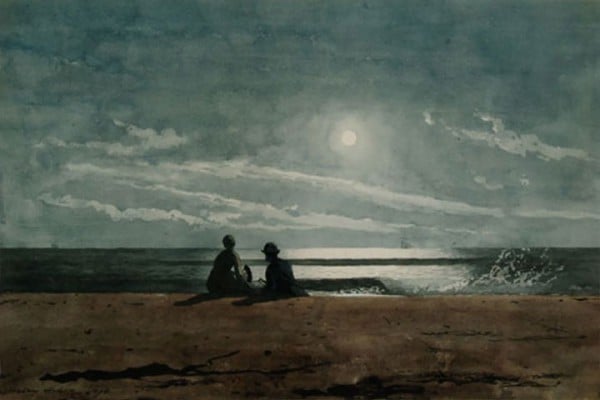
Summer art shows, especially in tourist towns, can be sleepy, safe and offer few surprises. Yet a small but choice show in Cooperstown, NY, in the foothills of the Adirondacks, argues that the turmoil in legendary American painter Winslow Homer‘s life went way beyond the roiling white-capped waves seen in his New England seascapes.
“Winslow Homer: The Nature and Rhythm of Life,” at the Fenimore Art Museum through August 24, addresses and claims to answer a long-standing debate over his sexuality—was he gay, or so heartbroken by a woman’s rejection he just never loved again? It also features a painting he once sliced in half in anger and despair in answer to critics who called it a “deformity” and “a horror.” The show charts his career over 50 years, from Civil War–era images notably sympathetic to African-Americans, to his death in 1910.
Overall, the show reclaims Homer from the Brahmin ghetto, that Maine-to-Massachusetts corridor, by showing works culled from his trips to the Bahamas, Tampa, New Jersey, the Hamptons, Virginia, and England. It looks at Homer as “a brand-new artist,” says museum president and chief executive Paul D’Ambrosio. “It’s a show that needed to be done.” He adds that many of these works from the collection of early 20th-century Beech-Nut gum and baby food mogul Bartlett Arkell and from Homer’s own collection “have never been seen together.”
The artist’s private life is only one aspect of the somewhat autobiographical show, but art historians have slaughtered trees over the years on the topic of Homer’s sexual orientation. On view at the Fenimore, among Watching the Breakers (1896) and Sailing Out of Gloucester (c. 1880), is Moonlight (1874), an atmospheric watercolor of a man and woman sitting adjacent but separate on a dark East Hampton beach, his cane tipped suggestively at her open fan. The curators and catalogue argue here that the woman is Helena de Kay, the long-sought “mystery woman” who broke Homer’s heart when she married another man. He never recovered. (Notably, in a letter, Homer once compared de Kay to a Beethoven symphony.)
There are alternative theories: some prominent scholars argue that Homer was, at best, ambivalent about women; they cite his very many paintings of fishermen, soldiers, and hunters and/or link him romantically to artist Albert Kelsey. The glbtq: The Online Encyclopedia of Gay, Lesbian, Bisexual, Transgender, and Queer Culture argues that “a pensive red-haired woman, featured in many of his works. . . . Homer based this notably ‘masculine looking’ woman upon a young boy” who posed for him. But the evidence that it is de Kay and Homer in the moonlight in Moonlight, and that he never recovered from the romance, is “sketchy and circumstantial” writes Homer scholar Sarah Burns, but compelling.
Winslow Homer, Sailing Out of Gloucester (c. 1880). Collection of the Yale University Art Collection, New Haven, Connecticut.
Cooperstown is an unlikely site for the debate: It’s better known as the home of American author James Fenimore Cooper, who wrote The Last of the Mohicans, and of the National Baseball Hall of Fame. (Indeed, as the Homer show opened, Cal Ripken, Jr., and Phil Rizzuto were checked into the Otesaga Hotel adjacent to the museum.) But both institutions, art museum and baseball one, were founded by the same person: noted art collector Stephen Carlton Clark, whose father was an early investor in Singer Sewing and whose brother Sterling founded the Clark Art Institute in the Berkshires.
As for Homer, he kept his love affairs, secret or otherwise, to himself. In an oblique 1908 note to a would-be biographer (as quoted some years ago in Smithsonian magazine) he wrote: “I think that it would probably kill me to have such a thing appear–and as the most interesting part of my life is of no concern to the public I must decline to give you any particulars in regard to it.”